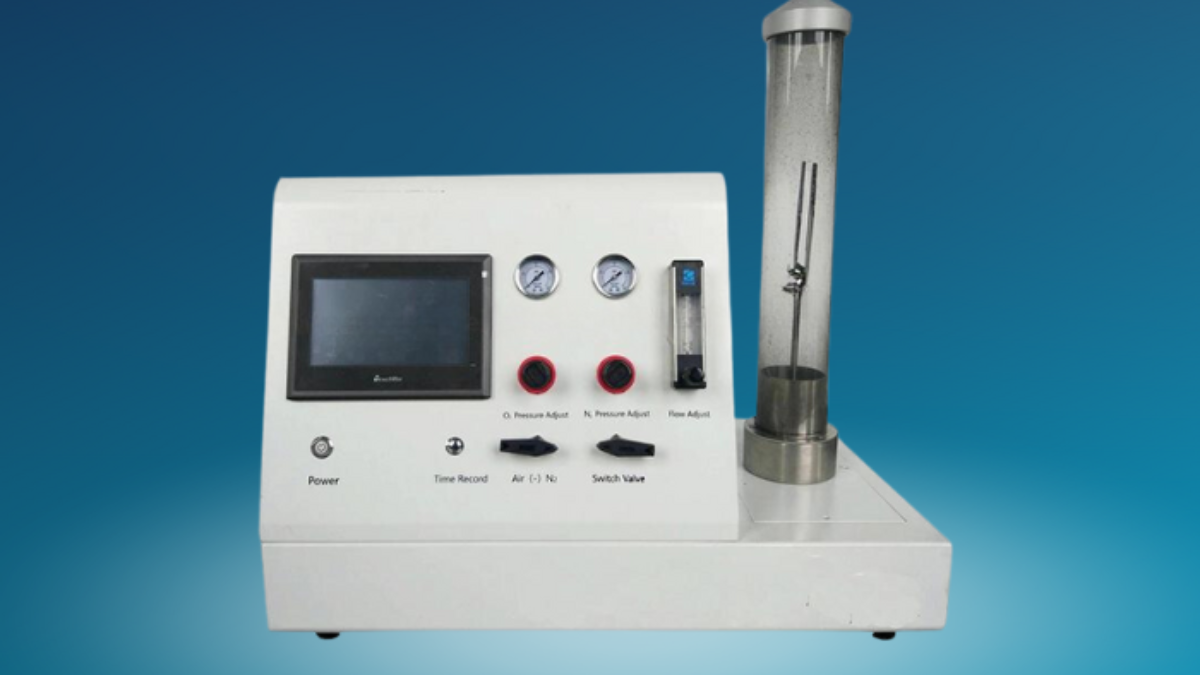Oxygen Index Testing As per standard ASTM D2863
Understanding Oxygen Index Testing According to ASTM D2863
Introduction:
- In the field of material safety, particularly with regard to flammability, oxygen index testing plays a critical role. The ASTM D2863 standard, "Standard Test Method for Measuring the Minimum Oxygen Concentration to Support Candle-Like Combustion of Plastics (Oxygen Index)," outlines a precise method for assessing the flammability of materials by determining the lowest concentration of oxygen that supports combustion. This test is widely used in industries where fire safety is paramount, such as automotive, aerospace, electronics, and construction.

Purpose of Oxygen Index Testing:
The primary goal of oxygen index testing is to evaluate the flame retardancy of a material. The test measures the Limiting Oxygen Index (LOI), which is the minimum concentration of oxygen in a nitrogen-oxygen mixture that will sustain combustion. The higher the LOI value, the more flame-retardant the material, as it requires a greater amount of oxygen to maintain a flame.
Why is Oxygen Index Testing Important?
Flammability is a critical factor in material selection, especially in industries where safety is a top priority. Knowing the oxygen index of a material helps engineers and designers make informed decisions to minimize the risk of fire-related accidents. The test results are also crucial for meeting regulatory standards and ensuring compliance with fire safety codes.
The ASTM D2863 Test Procedure:
- Test Setup: The test is performed using a specialized apparatus where the material sample is placed in a vertical glass column. A controlled flow of oxygen and nitrogen gas is introduced into the column.
- Ignition: The material is ignited at the top using a standardized flame. The technician adjusts the oxygen level in the mixture to find the minimum concentration at which the flame can be sustained.
- Observation: The sample is observed to determine whether it continues to burn or self-extinguishes. If the flame is sustained, the oxygen concentration is reduced until combustion is no longer possible.
- Result Calculation: The Oxygen Index (OI) is calculated as the percentage of oxygen in the gas mixture at which the material can just continue to burn. This value helps classify the material’s fire resistance.
What LOI Values Mean:
LOI < 20%: Materials with an oxygen index of less than 20% are considered highly flammable. They require a low oxygen concentration to ignite and continue burning, making them unsuitable for environments where fire safety is critical.
LOI 20-30%: These materials are moderately flame-resistant. While they do not ignite easily, they can still burn in higher oxygen environments.
LOI > 30%: Materials with an oxygen index above 30% are highly flame-retardant. They need a much higher oxygen concentration to sustain a flame and are often used in applications requiring strict fire safety measures.
Applications of Oxygen Index Testing:
Construction Industry: Oxygen index testing helps in selecting flame-retardant building materials, such as insulation and wall panels, ensuring compliance with fire codes.
Aerospace: In aircraft construction, it is critical to use materials that are difficult to ignite or burn. The LOI values provide engineers with the information needed to choose materials that enhance safety.
Automotive: In the automotive industry, interior materials, such as seats and dashboards, are subjected to oxygen index testing to reduce the risk of fire in the event of accidents or electrical failures.
Electronics: The plastic components used in electronic devices are tested to ensure that they resist ignition, thereby reducing fire hazards during usage.
Benefits of Oxygen Index Testing:
Ensures Compliance: Many industries have stringent fire safety standards. Conducting oxygen index testing helps manufacturers meet these regulations and avoid potential penalties.
Improves Safety: By identifying materials with higher LOI values, manufacturers can produce safer products that reduce the risk of fire-related incidents.
Cost-Effective Material Selection: Knowing the flammability characteristics of materials allows for better decision-making in the early stages of product design, potentially reducing costs associated with recalls or safety redesigns.

Conclusion:
- Oxygen Index Testing as per ASTM D2863 is a reliable and standardized method for evaluating the flammability of materials. By determining the minimum oxygen concentration required to sustain combustion, this test provides valuable insights into material performance in fire-prone environments. Industries such as aerospace, automotive, electronics, and construction benefit greatly from understanding these properties, ensuring both regulatory compliance and enhanced safety.

